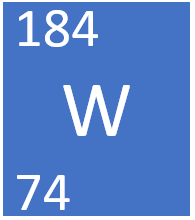Contents
Key Stage 2
Meaning
Key Stage 3
Meaning
Tungsten is a transition metal element, on the Periodic Table, with an atomic number of 74.
About Tungsten
Molecular Structure
- Tungsten has the chemical symbol W.
- Tungsten atoms join together in large numbers to form a giant metal molecule.
Atomic Structure
- Tungsten as 74 protons and 108 neutrons in its nucleus giving it an Atomic Number of 74 and an atomic mass of 184.
- Tungsten is in Period 6 of the Periodic Table because it has 6 electron shells.
Properties
- Tungsten is a metal element so it is a good thermal conductor and a good electrical conductor.
- Tungsten is a shiny solid at room temperature.
- Tungsten is malleable.
- Tungsten is sonorous.
- Tungsten is ductile.
Key Stage 4
Meaning
Tungsten is a transition metal element, on the Periodic Table, with 74 protons in the nucleus.
About Tungsten
Molecular Structure
- Tungsten has the chemical formula W.
- Tungsten atoms join together in a giant metallic structure.
Atomic Structure
- The most stable isotope of Tungsten has 108 neutrons in its nucleus giving it an atomic mass of 184.
- Tungsten is in Period 6 of the Periodic Table because it has 6 electron shells.
- Tungsten loses electrons to form positive metal ions.
Properties
- Tungsten forms ionic bonds with non-metals.
- Tungsten is a metal element so it is a good thermal conductor and a good electrical conductor.
- Tungsten is a shiny solid at standard temperature and pressure and has a high melting point.
- Tungsten is malleable.
- Tungsten is sonorous.
- Tungsten is ductile.

